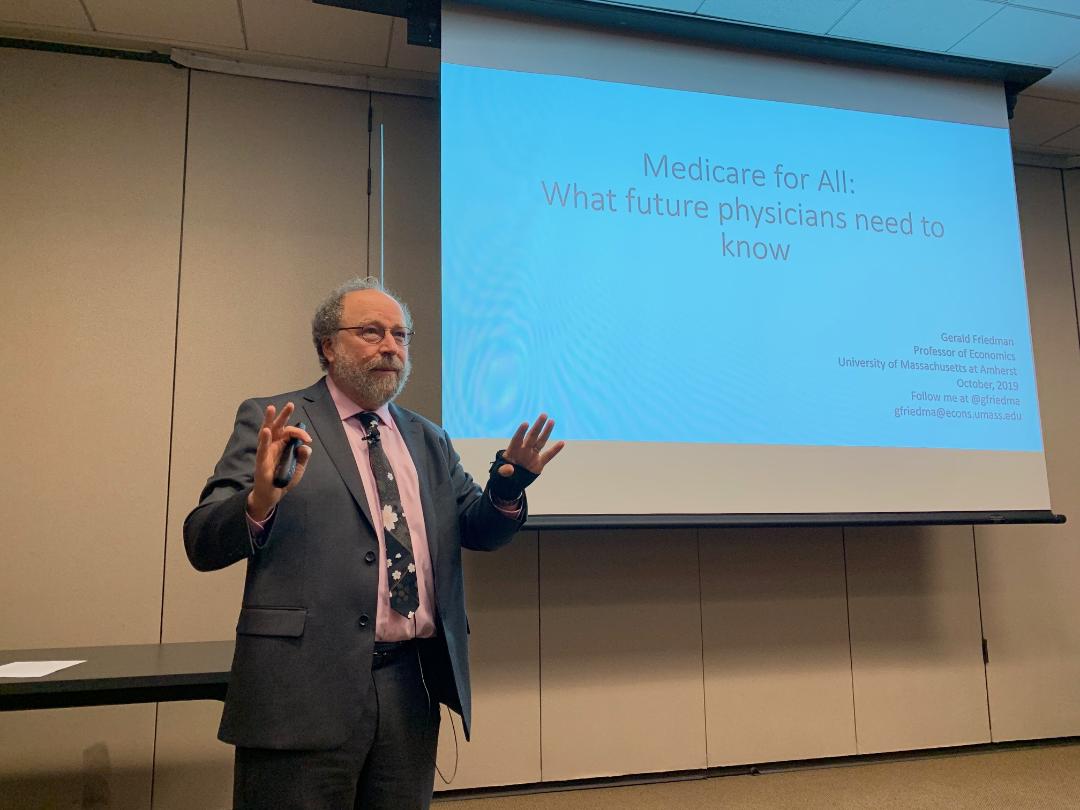There have been numerous academic studies that analyze and compare healthcare systems across the globe and in Washington state. Universal healthcare is well established to provide higher quality and more cost-effective care to more people. Below are a few studies we consider most relevant to our work.

Whole Washington consulted with Dr. Gerald Friedman, a professor of economics at University of Massachusetts Amherst, in creating a budget and financing plan for The Washington Health Trust. As part of this, Dr. Friedman ran an economic analysis of the cost of healthcare in Washington and the economic impact universal healthcare would have on the state. Dr. Friedman’s original report was published in 2018 and was updated in 2021. While economic studies can be intimidating, Dr. Friedman’s analysis is both thorough and accessible and highly recommended reading.
Dr. Friedman’s 2018 study estimated total healthcare spending costs for the year of 2019 and then estimated the economic impact The Washington Health Trust would have both in terms of increased costs through greater usage, and savings found through administrative efficiencies, fraud reduction, and market power. His study estimated how the needed revenue could be raised through a combination of taxes and projected a $9.8 billion reduction in total healthcare spending compared to the status quo.
Friedman revised his study in 2021 to investigate further sources of savings and to recalculate revenues based on an updated financing plan introduced in the then-newest version of the Washington Health Trust introduced into the state Senate as SB.5204. The 2021 study can be read in isolation but works best if read as an addendum to the original 2018 study. His updated analysis projects even greater savings than the original report and estimates a $12.7 billion reduction in total healthcare spending compared to the status quo.

The Washington state legislature created a Universal Health Care Work Group and commissioned a report from them published in 2022. The report analyses three models of healthcare expansion for Washington state. Models A and B were universal healthcare models while Model C expanded healthcare to undocumented individuals but did not achieve universal coverage.
Model A was a “state single payer” model in which Washington state would create a state health insurance plan that covers all residents and eliminates the bulk of private spending found to save approximately $2.5 billion in its implementation year and $5.6 billion annually once fully transitioned to.
Model B would create a similar state plan but instead of having the state administer the plan, would contract with private insurers and offer enrollment through the exchanges. Model B was able to achieve universal coverage but only saved just under $800 million compared to the status quo.
Models A & B are models for statewide universal healthcare while The Washington Health Trust is legislation and therefore is not interchangeable with either model. However – The Washington Health Trust can be understood as “Model B” when first established with a transition plan to become “Model A” as federal waivers, voluntary enrollment, and employer participation.

The 2018 Washington State Legislature directed the Washington State Institute for Public Policy (WSIPP) to conduct a study of single-payer and universal health coverage systems. This task was carried out over the publication of an interim report in 2018 and a final report in 2019.
The interim report looked at universal single payer healthcare proposals across the United States and the studies that have been run analyzing their potential impact and finds a general consensus among studies that single payer saves money both when implemented at a state and federal level.
The final report looks at the healthcare systems of other high-income countries and finds universal coverage and cost controls successfully implemented across multi-payer and single-payer systems though finds that greater administrative savings especially for providers are found in single-payer countries.

The first version of The Washington Health Trust (at that time, called the “Whole Washington Health Trust”) was introduced into the Washington legislature in 2019 by Senator Bob Hasegawa as Senate Bill 5222 (SB.5222). As part of the new legislation’s vetting the state Office of Financial Management published a Fiscal Note to analyze the costs and impacts on taxpayers. The note breaks down costs by state department and includes budget for legal challenges.

In 2013 Public Citizen published a report that outlined the legal and administrative challenges associated with establishing universal healthcare at the state level. Many of these challenges including navigating federal law to acquired federal waivers that allow a state to avoid court challenges while incrementally integrating federal programs, their funding, and their enrollees into a state program. While significant challenges are anticipated, the report makes eight recommendations for states that would like to pursue universal healthcare.

In 2020 People’s Policy Project published a paper using data provided by the International Union of Painters and Allied Trades (IUPAT) to determine what the net financial impact of implementing Medicare for All would be on their members and finds that it would save members between $4,868 and $7,866 per year.

Labor Campaign for Single Payer published a briefing paper in 2017 that looked at union-negotiated multiemployer healthcare plans and the impact that federal reforms like the Affordable Care Act and Medicare for All have on these plans and their enrollees. While it argues that universal single-payer healthcare implemented at the federal level would be the best solution to provide workers and their families reliable, affordable, and high quality coverage, it suggests that statewide reform may come first and identifies ten key considerations for state single-payer healthcare proposals.
